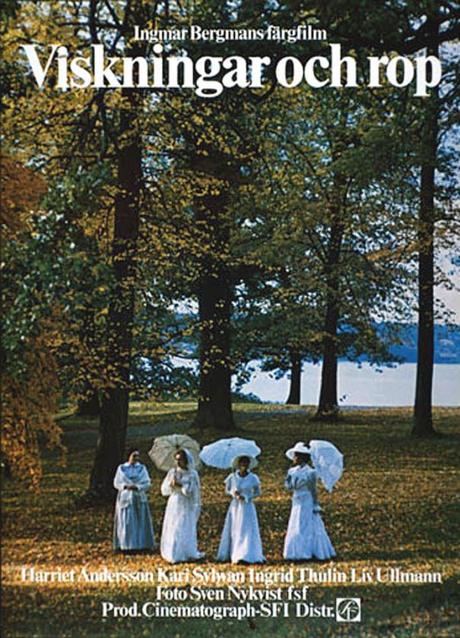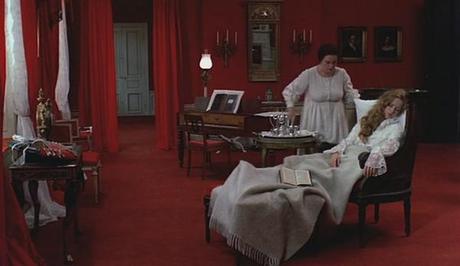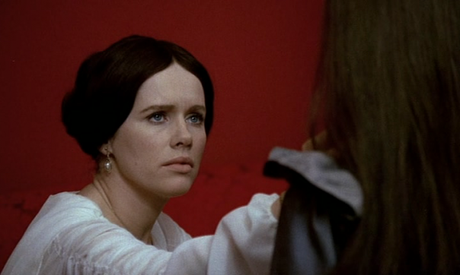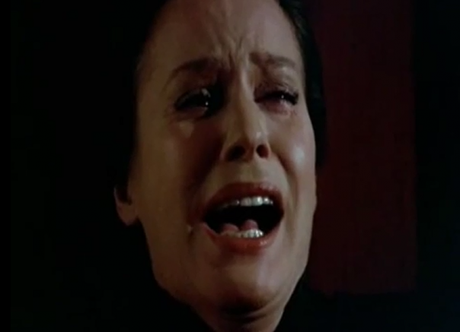
Welcome to the All-Time Favourites Series. This series examines 25 of the greatest films I’ve ever seen, looking at them in depth with analyses of what makes them great, and cutting down to the most basic level, looking at plot, cinematography, writing, direction, acting and other things, to see what makes these great films tick. To read more on the series, click here. This week’s movie is Ingmar Bergman’s 1972 film Cries and Whispers.

Cries and Whispers is the culmination of all the building tension Ingmar Bergman presented in his films in the 60s. Films like The Virgin Spring and The Silence examined the relationship between siblings and family members; Through a Glass Darkly and Winter Light dealt with religion; and Persona, Hour of the Wolf and A Passion dealt with, on various levels, insanity. These themes Bergman built on and released in one of his most explosive, brilliant, horrific, revelatory films. This was the movie his career was promising, and when it was delivered, audiences and critics were stunned, for different reasons. Audiences in general disliked it, feeling it was too morbid and close-to-home. It was these aspects, however, that critics praised, among others, including Roger Ebert, who said of the film: “Although we are all likely to see many films in our lives, there will be few like this one. It is hypnotic, disturbing, frightening. It envelops us in a red membrane of passion and fear, and in some way that I do not fully understand it employs taboos and ancient superstitions to make its effect. We slip lower in our seats, feeling claustrophobia and sexual disquiet, realizing that we have been surrounded by the vision of a film maker who has absolute mastery of his art. Cries and Whispers is about dying, love, sexual passion, hatred and death – in that order.”

Ebert is right. With this film, Ingmar Bergman shows absolute mastery of the filmmaking art. Every shot, carefully and lovingly composed by him and the greatest cinematographer in history, Sven Nykvist, is perfect. And the production design is even more impressive; in almost every shot, something red is visible, and in some scenes, the screen is completely enveloped in red, to a shocking and disquieting degree. Instead of fading to black or white or simply to the next scene, Bergman’s camera often fades to red, and one can imagine the reaction of an audience in a cinema. If there were three Bergman films I were to be given an opportunity to see in the cinema, they would be Persona, Fanny and Alexander and this film. Bergman and Nykvist were known for their black-and-white productions (few films juxtapose the frightening difference between the two colours as well as Persona), but in 1972, Cries and Whispers was only the fourth film Bergman made in color (the previous three being All These Women, A Passion and The Touch), and it was the most impressive.
The film’s story concerns the relationship between three sisters: Agnes (Harriet Andersson), who is dying; Maria (Liv Ullmann), who is swept up in her own selfishness; and Karin (Ingrid Thulin), who has become cold and bitter after a marriage so heinous she mutilated herself. The latter two are there to comfort Agnes, but turn out to be less interested in her than Anna (Kari Sylwan), the maid who has been hired to care for her, and in times of great pain, acts like a mother to Agnes. But Agnes, in the short time of living she has left, is mostly alone. The film’s opening scene contains a heartbreaking, shocking closeup of her face as she moans in pain. Bergman holds this shot, and holds it, and holds it, for an unbearably long time. And I swear to God, the longer Bergman held the shot, the more pain I felt inside myself. Then Bergman and Nykvist continue to track her haunting, deathly face as she walks around the room and begins writing in her diary, a book that will be a revelation into her mind.

Then there is the childlike Maria, dressed in white, not an innocent lamb but pretending to be to further herself. After her comes the woman that I daresay is the film’s most important character; or rather, the actress who plays her gives such a rousing, haunting performance that you can hardly move when she speaks, and her icy stare sends shivers down your body. I am talking of Karin, or more accurately, the actress who portrays her: Ingrid Thulin. Thulin, who I believe to be history’s greatest actress, previously gave rousing performances in Bergman films such as Wild Strawberries, Brink of Life, Winter Light and The Silence, among others. In those latter two particularly, she gave performances so vivid, so shockingly powerful, that the film would be much, much less without her. The same applies to Cries and Whispers. Look at her: her bitter, sardonic grins; her shocking, devastating anguish; her desperate, hoarse cries. There is a scene where she confronts Maria, and curses her and her façade of pointless normality. Then she leaves the room and screams. And when I say she screams, she really screams. I have never seen or heard in the movies such a scream, ever, and I doubt I will again. This scream is long, powerful, and there is an uncomfortable moment when it ceases that you can still hear its echo in the distance. I can’t watch this scene anymore without shivering or squirming.
But the moments I’m describing are simply that: moments. They should be left for the viewer to experience, and not for me to spoil. There are a lot of mysterious enigmas in Cries and Whispers, and only a precious few of them are explained in the flashbacks that take up much of the first half of the film. Many of the secrets remain just that; secrets, clouded by mystery and lost in the light. Even if before now you have not heard of Cries and Whispers, and if its critical acclaim and success are not enough to convince you to watch it, consider the fact that it was nominated for five Academy Awards, including Best Picture. Yes, it seems the Academy themselves were as moved and haunted by this film as I was, and I can only hope others will share this experience. Cries and Whispers was the sixth film from Bergman I ever saw. Now, as I write this, I have seen more than thirty. The morning after I saw this film, I woke up with the echo of Ingrid Thulin’s screams in my head, and the moans of Harriet Andersson. To have such memorable verbal utterances are tributes to the power of the actresses, but I doubt I would have remembered them as clearly as I did if they weren’t in a Bergman film. Bergman is one of the directors to whom I take solace, and into whose body of work I lay silently, accepting the comfort of its brutality and the radiance of its beauty.


